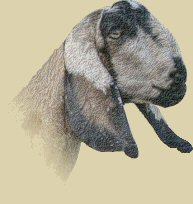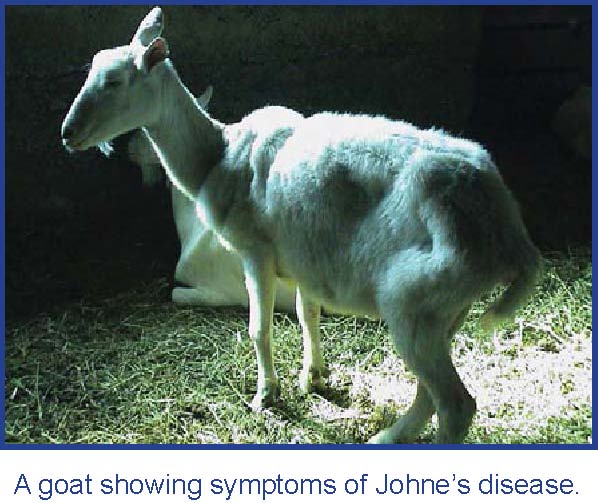

 |
 |
|
|
||||||||||||||||||||||
| DISEASES and MANAGEMENT |
||
|
CASEOUS LYMPHADENITIS or CHEESY GLAND Caseous lymphadenitis (CLA) is a recurring bacterial disease in goats that causes ab-scesses in lymph nodes in internal organs and under the skin. Cause Cheesy gland is caused by infection with the bacterium Corynebacterium pseudotuber-culosis. The organism occurs in abscesses as well as in the gut and faeces of the goat. It can survive for up to 4 months on the ground and on fences, feed troughs and head bails depending on shelter from wind and sun. Spread of Infection The bacteria are abundant in the pus inside abscesses. When these abscesses burst, the pus containing bacteria is transferred to the environment around the goat pens. The infection is then picked up by other goats through contamination of wounds and broken skin. The common behavioural habit amongst goats of frequent licking, as well as of rubbing their heads and necks against fence posts and sheds, allows the rapid spread of cheesy gland. Where goats are kept in small yards, the direct contact and close grazing of contaminated grass or feeds in feed troughs also encourages spread. Dairy goats that are placed in head bails for milking are particularly prone to being in-fected through splinters around the neck. Contaminated grooming gear can spread the bacteria to other goats. Once the bacteria enter the goat’s body, they spread in the bloodstream until they become localized in the lymph nodes, organs or subcutaneous tissue. Signs Infected lymph nodes grow to become large abscesses ranging in size from an egg to a grapefruit. The contents are thick green/yellow cheese-like pus, hence the common name ‘cheesy gland’. Treatment In individual goats with large abscesses, lance the abscess at the lowest point. Flush out the cavity with disinfectant after the pus has drained. Because pus is the main method of spread, it should be collected and disposed of safely by burying or treating with disinfectant. Once the cavity is clean, infuse with antibiotic cream or ointment to assist recovery. Personal Hygiene After handling goats infected with cheesy gland, ensure you take personal hygiene measures, especially if you have cuts and abrasions on your hands or arms. These wounds can become infected, involving lymph nodes, which in turn become tender and swollen.

Prevention Vaccination is the most effective way to control cheesy gland. The vaccine against cheesy gland is combined with vaccines for other diseases. The three-in-one vaccine protects against cheesy gland, pulpy kidney (entrotoxemia) and tetanus. It is important to give two initial vaccinations 4-6 weeks apart followed by an annual booster for ongoing protection. See further: Files\https://www.mla.com.au/research-and-development/animal-health-welfare-and-biosecurity/diseases/infectious/cheesy-gland/
|
|
HEALTH REGULATIONS
Back
to
CARE
& MANAGEMENT South Australian authorities impose strict heath regulations concerning two major diseases. These are CAE and Johne's Disease. What is CAE? Caprine arthritis/ encephalitis is a disease of goats caused by a lentivirus. This disease is also called chronic arthritis-synovitis, big-knee, viral leukoencephalomyelitis, progressive interstitial pneumonia and caprine retrovirus disease. It causes chronic arthritis and occasionally progressive interstitial pneumonia or chronic mastitis in adults and leukoencephalomyelitis in young kids. Clinical signs include swelling of the carpal joints and lameness in adults. Other joints become involved as the disease progresses. Kids show nervous signs such as lameness, ataxia, hindlimb placing deficits, hypertonia and hyperreflexia. The virus is mainly spread between goats through the ingestion of infected milk by kids or adults. Adult goats can also become infected by exposure to infected milk droplets during milking. The virus can also be spread by respiratory secretions, saliva and tears when goats are kept in close quarters. Transfer sometimes occurs by exposure to blood on gear such as vaccination needles, tattooing equipment, dehorners or foot/hair shears, or through exposure to open wounds for example, torn ears after ear tagging. Venereal spread via semen and in utero spread to kids are less likely but can occur. The virus usually enters a clean property in an infected goat. The goat may or may not be antibody positive for CAE at the time of first blood testing because of the delay between exposure to the virus and the development of antibodies. Control programs have been
conducted in many countries but CAE is still causing problems in dairy
goat populations world-wide. |
|||
| What is Johne's Disease? Johne's disease (pronounced "Yo-nees") is a serious wasting disease of goats, which can lead to loss of production and death. The disease affects animals by causing thickening of the intestinal wall resulting in a reduction in the normal absorption of food. The disease is caused by a bacterium (Mycobacterium paratuberculosis) that lives mainly in animal intestines, but can also survive in the outside environment for several months. The disease is seen more often in dairy goats than meat or fibre goats, but all breeds may be infected if they come into contact with the bacterium. Goats acquire infection at an early age through eating contaminated pasture, or drinking contaminated milk or water. The signs of disease develop slowly and the disease is rarely seen in young animals. http://www.adga.org Click on "About Dairy Goats' then select 'Johne's Disease' from the articles. |
 |
||
|
|
|||
South Australian Health Schemes: |
|
| 1.MASSA
(
Market Assurance Scheme of South Australia)
This is a health program, run
by the DGSSA Inc committee, for the
monitoring of CAE (Caprine Encephalitis) and JD (Johne's
Disease)
for South Australian members. All shows held
in South Australia require
documentation to demonstrate
that the goats are tested negative to
both of
these Diseases. All Sales and Purchases of dairy goats should have a
current health certificate to say that the goats for sale and the WHOLE
herd test negative. Rules are slowly
being introduced throughout Australia to say that unless on a Heath
Scheme animals cannot be sold, purchased or shown
or they have been
tested negative within the past 90 days. This is on the NLIS forms. Our scheme has been
acknowledged by
PIRSA (Primary Industry and Resources S.A.).
It makes showing and selling easier. If you are a member of MASSA, only
one piece of paper, saying your animals have been tested negative, is
needed to accompany your entries or sales. NLIS require other paper work
to accompany any sales whether that be to local, interstate or overseas
export.
If you are not on our scheme your will need to produce and forward, with
your entries or sales, at least 2 years of whole herd negative testing
for your goats and any other goats or stock introduced to your property.
It
is very simple to become a member of MASSA.
Simply
apply to the committee, present the one
or
two
recent negative test for both CAE & JD,
plus a map of your property to
say where your goats are kept in relation to other stock etc.
For continuation,
conduct an annual negative test for
both diseases for a couple of years,
then you may be eligible for bi-annual testing.
You are required to have a stock movement list as well to state if goats
have been sold, introduced, shown or
taken out to a service.
(again, see 'Forms You
May Need' in the main menu)
The Branch does impose a small fee to cover processing costs.
2.
MAP This is an
Australia-wide program for the monitoring of JD only. This is for many
species of stock such as cattle, sheep, deer and Alpacas.
|